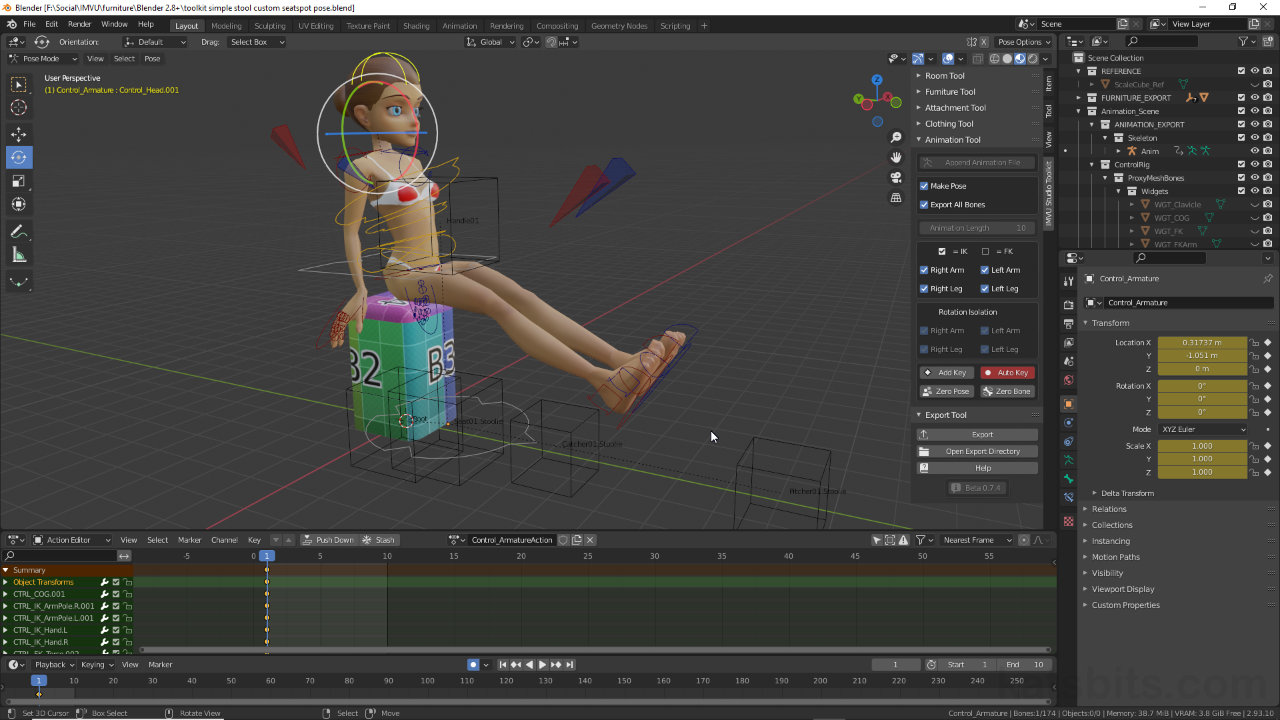Toolkit – Furniture + Custom Poses
Table of Contents
Description
In this exercise we’ll take a look at adding custom seating, or pose spots, to basic furniture item using IMVU Studio Toolkit. Continuing with the Furniture Tool, with the mesh made and prepped as a normal item, a custom seat-node set is added, identified with a unique label, and positioned. This is saved and then exported to FBX (file #1). To create the pose associated with the furniture item, an Animation Tool project is created, into which the furniture mesh and seat node are brought in as reference (Using Append). A pose can then be created around this, saved and then exported to FBX (file #2). In Studio the two components are imported separately and assembled so the animation triggers when the seat is used.
Duration: total c. 20 mins (00:20:00).
Info: 1080p.
Suitability: Beginner+.
Source: KatsBits – Toolkit Simple Stool Custom (c.1.0 MB, *.blend, *.fbx, *.png). Requires installation of the toolkit for Blender. Open in Blender 2.93 LTS (preferred) or above.
Product ID: Stoolie Custom Pose (PID 62486898).
Other tutorials in this series
– Toolkit – Basic Furniture.
– Toolkit – Furniture + Poses.
– Toolkit – Furniture + Custom Poses.
Design note: The basic process of creating custom seat or pose spots for furniture is basically the as it is for sitting and standing spots except for the appended label attributed to the seat node itself [1]. In other words there is nothing inherently special about custom seat nodes other than the label – in practice this might means a standard *.Sitting or *.Standing node set can be renamed to create a custom instance, or ‘reset’ changing it back to “Sitting” or “Standing” (this can be done at any time).
Node names associated with custom seating or pose spots [1] – Catcher and Pitcher do not specifically need to be changed but doing so helps with identification within the Outliner.Critical – Import/Append: the ‘pose’ part of a project can be initiated two ways;1) creating a new, clean, Animation Tool project into which furniture mesh(es) and seat node(s) references are imported using Append
2) adding the Animation Tool to an open Furniture Tool project.
Tool Selection
In either case ensure absolutely nothing is selected in the 3D Viewport [2] as this can cause issues for the Toolkit come time to export – each kit is organised specific to the tool being used [3], if something is active when importing or appending, Blender can place the incoming data within context of the active selection, it then becoming a ‘child’ of that, which breaks the internal hierarchy. It’s crucial to be aware of this when using multiple tools on the same project.
When using more than one Tool on a given project ensure nothing is active or selected in the 3D Viewport [2] to prevent issues with the resulting hierarchy [3] and subsequent Tool functionality.Action Triggers
Critical – Name/Trigger: for Actions in Studio, sequences contained within the Ensemble can be triggered manually or automatically based on the Name/Trigger property [4]. Manually activated poses require a custom label Users types in chat, “exercise” for example, or can be selected from the Avatar context menu (right-click the avatar). To automatically activate a pose a special Name/Trigger is used, “stance“, instead of the seat node label, i.e. stance.[label] (stance.Stoolie) not seat01.[label] (seat01.Stoolie). The label is case sensitive.
When setting up the Action make sure the Trigger is correctly set. To auto-play this is stance.[Label] [4].Import Order
When assembling furniture the first FBX to import is generally the furniture file as this includes the necessary mesh and skeleton data for a functional product. If other FBX files are brought in, and they too include skeleton data, some functionality may break so the products skeleton will likely need to be ‘reset’. After importing the additional files, in Component access Skeleton [5] properties and correct the Asset [6] used in the Inspector appropriately – using the Furniture Tool this will be RootNode.xsf.
Importing several FBX files may break a furniture item, typically requiring the Skeleton [5] to be reset in the Inspector (Asset) [6].Pose Mode
The animation tool requires the animation rig, the wireframe objects and shapes, to be in Pose Mode. When initially selecting the rig if it highlights orange this indicates its in Object Mode not Pose Mode. To switch, ensure the rig is selected, then from the Interaction Mode selector, click Pose Mode. The rig will changes its appearance, different parts changing colour, indicating they can be selected, moved and posed for sequence creation.
Make sure to be in Pose Mode when using the Animation Tool.
Timestamps
Times are approximate;
– 00:00 : Start, Seat Setup & Export
– 03:30 : Avatar Setup
– 09:00 : Pose Creation & Export
– 12:00 : Assembly – Furniture
– 16:30 : Assembly – Pose





